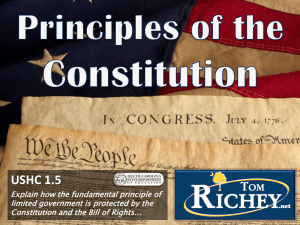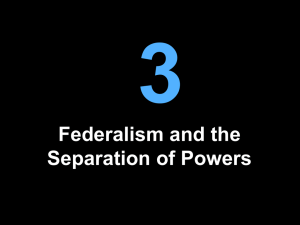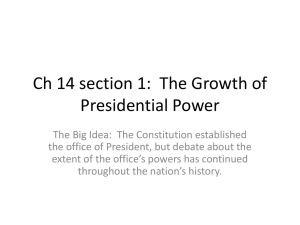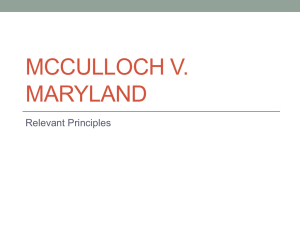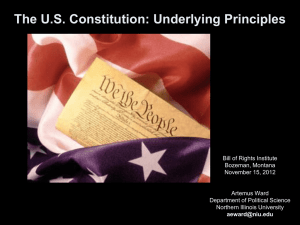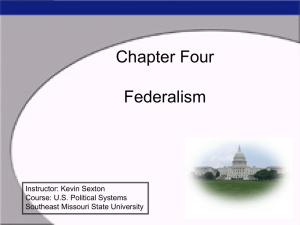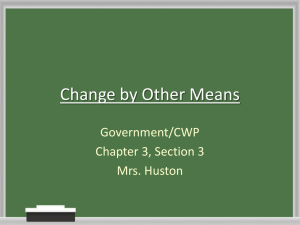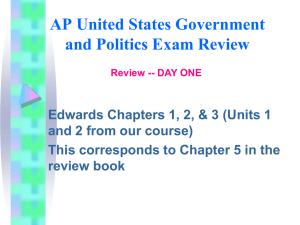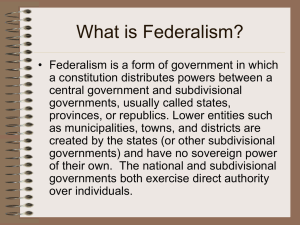Federalism PowerPoint
advertisement
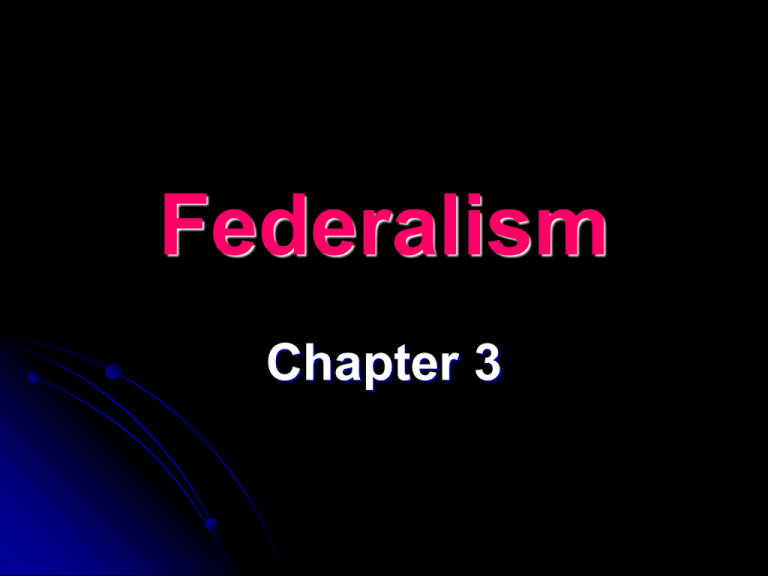
Federalism Chapter 3 Figure 3.2- Systems of Government Source: O’Connor and Sabato, American Government Roots and Reform Federalism Defined A system of government in which a written constitution divides the powers of government on a territorial basis between a central or national government and several regional governments usually called states or provinces. Why Federalism? Dilemma: How would framers create a new central government that would be strong enough to meet the new country’s needs but at the same time preserve strength of the existing states? Division of Powers Each level of government has its own set of powers. Neither level can act alone to change the basic division. Each level acts through its own agencies, officials, and laws. Both levels derive their powers from the people! Dual System of Govt Two basic levels of govt Each has own authority Each operates over the same people over the same territory at the same time Major Strength(s) Allows local action in matters of local concern. Allows for local traditions, needs, and desires vary from one State to another Allows for national defense, foreign affairs, disaster relief Enumerated Powers Spelled out in the Constitution. Article 1 Section 8 – gives these powers to Congress Include: taxation, coinage of money, regulation of interstate commerce, national defense. Implied Powers Article I, Section 8, Clause 18 gives Congress powers “necessary and proper” to carry out enumerated powers. AKA the “elastic clause” Necessary & Proper “…to make all Laws which shall be necessary and proper for carrying into Execution the foregoing Powers and all other Powers vested by this Constitution in the Government of the United States, or in any Department or Officer thereof.” Powers Denied Fed Govt Constitution denies some powers in writing Levy duties on exports Prohibit freedom of religion, speech, press, or assembly Conduct illegal searches or seizures Deny someone a speedy and public trial/trial by jury. Powers Denied Fed Govt 2 Denied by “silence” of Constitution: nothing said Examples: Create public school system for the nation Uniform marriage and divorce laws Set up local governments Powers Denied Fed Govt 3 Denied by nature of a federal government system Example: Congress can not tax any of the States or their local units. To do so would give the Federal government the power to destroy state governments. The States Reserved Powers (Police Powers) 10th Amendment Powers not given to the Federal government by the Constitution and not denied the States are reserved to the States. The sphere of powers held by each State is huge. The States 2 Most of what government does in the US is done by the States (and local govts). Includes police power—the power of a State to protect and promote the public health, the public morals, the public safety, and general welfare. Denied to the States Explicitly stated in Constitution Making foreign treaties, printing or coining money Inherently denied Can’t tax federal government May be limitations in individual State constitutions Concurrent Powers Powers possessed and exercised by both National and State governments Levy and collect taxes Define crimes and set punishments Figure 3.3- Distribution of Power Source: O’Connor and Sabato, American Government Roots and Reform Denied to all levels of government Bill of Attainder Law declaring an act illegal without a judicial trial Ex post facto laws Laws declaring an act illegal (creating punishment) after it has already been committed. Relations Among the States Full faith and credit clause Judicial decrees and contracts made in one state are binding and enforceable in another. Privileges and immunities clause Citizens of all states are afforded the same rights (under federal law). Relations Among the States Interstate compacts Agreements between states – must be approved by Congress. Extradition clause States must return criminals to other states where they have been convicted or are to stand trial. Supreme Law of the Land The Supremacy Clause Constitution stands above all other forms of law in the US “Linchpin of the Constitution” McCulloch v. Maryland Figure 3.1- Governments in the U.S. Source: O’Connor and Sabato, American Government Roots and Reform Relations Within the States: Local Government Local governments’ authority not granted by the people but through state governments States establish or charter their administrative subdivisions Local governments carry out or execute the duties of state governments on smaller scale Federalism and the Marshall Court Two rulings in the early 1800s had a major impact on the balance of power between national and state governments. McCulloch v. Maryland (1819) Upheld power of national government and denied the right of state to tax national bank Gibbons v. Ogden (1824) Upheld broad congressional power to regulate interstate commerce Dual Federalism: The Taney Court, Slavery, and the Civil War Dual Federalism Belief that having separate and equally powerful levels of government works best Implication: National government should not exceed its constitutionally enumerated powers. Dred Scott v. Sandford (1857) Declared the Missouri Compromise unconstitutional Congress lacked the authority to ban slavery in the territories. The Civil War, Its Aftermath, and the Continuation of Dual Federalism National government grew in size and powers after Civil War. 13th, 14th, and 15th Amendments Prohibited slavery and granted civil and political rights to African Americans. Supreme Court adhered to concept of dual federalism Plessy v. Ferguson (1896) Confusion over regulation of commerce Inconsistent rulings on scope of national power Setting the Stage for A Stronger National Government Sixteenth Amendment Authorized Congress to enact a national income tax Supreme Court had found congressional legislation in this area unconstitutional. Seventeenth Amendment Made senators directly elected by the people; removed their selection from state legislatures. Cooperative Federalism: New Deal and Growth of National Government The New Deal (1933-1939) intense governmental activity on the national level response to Great Depression required the exercise of tremendous national authority Supreme Court worried about scope of these programs in terms of regulating commerce and the economy New agencies and programs Court-packing plan response to anti-New Deal court decisions New Programs required cooperation across all levels of government. The Changing Nature of Federalism: Layer Cake to Marble Cake Layer cake federalism Each layer, national, state and local, had clearly defined powers and responsibilities. After New Deal, the nature of the federal system changed. Marble cake metaphor Cooperative federalism The relationship between the national and state governments that began with the New Deal Federal Grants and National Efforts to Influence the States Morrill Land Grant Act of 1862 New Deal Most grants were categorical grants Grant for which Congress appropriates funds for a specific purpose 1960s War on Poverty Direct assistance to states, local governments, and citizen groups Grants used to push national agenda rather than respond to state demands New Federalism: Returning Power to the States New Federalism Federal/state relationship proposed by Reagan administration during the 1980 Returned administrative powers to the state governments Reagan Revolution Block grants Broad grant with few strings attached Given to states by federal government for activity in specified area (education) New Federalism: Returning Power to the States The Devolution Revolution Contract with America Unfunded Mandates National laws that direct states or local governments to comply with federal rules and regulations but contain no federal funding to help pay the cost of meeting those requirements Personal Responsibility and Work Opportunity Reconciliation Act of 1996 New Federalism: Returning Power to the States Federalism Under the Bush Administration Budget shortfalls at federal and state level States raised taxes and cut services; received aid from federal government Federal government expanded post 9/11 Department of Homeland Security No Child Left Behind Example of preemption The Supreme Court: A Return to State’s Rights? From New Deal to 1980s: Court has generally expanded national authority at the expense of the states. Beginning in 1980s: Court interpretations altered Willingness to allow Congress to regulate in a variety of areas waned Webster v. Reproductive Health Services (1989) Planned Parenthood of Southeastern Pennsylvania v. Casey (1992) U.S. v. Lopez (1995) Sovereign immunity Bush v. Gore (2000) Figure 3.4- Supreme Court and Federalism Source: O’Connor and Sabato, American Government Roots and Reform Back The National Government and the 50 States or “What does “United States” really mean? Republican Form of Govt Constitution requires National Govt to “guarantee to every state in this Union a Republican form of government.” Generally understood to mean a “representative government”. Republican Form of Govt 2 Only time ever really big issue was after Civil War Congress declared several southern States did not have a “republican form of govt” States had to ratify the 13th, 14th, and 15th amendments Invasion/Internal Disorder Invasion of any one state is seen as attack on the US Federal system assumes that each state will keep the peace within its own borders If state can’t control some situations, then National govt provides protection against internal disorder Territorial Integrity National govt must recognize the legal existence and physical boundaries of each state. Congress must include members from each state Article V: equal representation in US Senate guaranteed Admitting New States Only Congress has this power Admitted 37 states since original 13 5 states created from exiting states (Vermont, Kentucky, Tennessee, Maine, and West Virginia Texas was independent first Admission Procedure Congress issues enabling act Territory frames a State constitution which is voted on by the people of the territory Constitution submitted to Congress for approval Approval = Statehood Conditions for Admission Each state enters on equal footing with other states Utah had to outlaw polygamy Alaska had to give up claims to land held by Native Americans Arizona had to end recall votes for Judiciary Cooperative Federalism Large and growing areas of cooperation between National government and the States Grants-in-Aid Grants of federal money or other resources to States or local units. Goes back to time of Northwest Ordinance of 1787 Criticisms of Grants-in-Aid Possible for Federal government to operate in many policy areas where it doesn’t have constitutional authority Blur the line of division of powers in our federal system Revenue Sharing – 1987 Congress gave an annual share of federal tax revenue to the States. Known as “shared revenues” Almost “no strings” attached Popular with States Ended with Ronald Reagan 1972 Categorical Grants For specific, closely define purposes Must use some of State’s own money (usually matching) Have agency to administer Obey federal guidelines for the grant Block Grants More broadly defined than categorical grants Health care, social services, welfare Fewer strings so easier for States to use Project Grants To States, localities, and private agencies (who apply for the grants) Many states use to fund job training NIH issues grants for medical research Other forms of Aid FBI helps State and local law enforcement Army & Air Force equip and train each State’s National Guard units Census Bureau data essential to State and Local planning Lulu Payments Federal monies going to local governments in areas where there are large federal landholdings. Made in lieu of (take the place of) property taxes which can not be collected from Federal government State Aid to Fed Govt State and local election officials conduct national elections Naturalization takes place most often in State, not federal, courts Federal criminals often arrested by State/Local officials Interstate Relations or “How well do the states play together?” Interstate Compacts No State may enter into any treaty, alliance, confederation. These kinds of arrangements are what causes so much trouble under the Articles of Confederation. Interstate Compacts2 However, the States may, with the consent of Congress, enter into interstate compacts —agreements among themselves and with foreign states. Over 200 compacts are now in force for law enforcement, resource development, conservation Table 3.1- Compacts by the Numbers Full Faith and Credit Clause Of the Constitution ensures that States recognize the laws and, documents, and court proceedings of the other States Exceptions to FF&C (1) One State cannot enforce another State’s criminal laws. and, (2) Full faith and credit need not be given to certain divorces granted by one State to residents of another State. Extradition Extradition is the legal process by which a fugitive from justice in one State is returned to that State. Extradition is upheld through Article IV, Section 2, Clause 2 of the Constitution. Governors are the State executives that handle the extradition process. If governor is unwilling to return a fugitive to a State, federal courts can intervene and order governor to do so. Privileges and Immunities The Privileges and Immunities Clause provides that no State can draw unreasonable distinctions between its own residents and those persons who happen to live in other States. Privileges and Immunities 2 States cannot, for example, pay lower welfare benefits to newly arrived residents than it does to its long-term residents, Saens v. Roe, 1999. However, States can draw reasonable distinctions between its own residents and those of other space, such as charging out-of-State residents higher tuition for State universities than inState residents.
